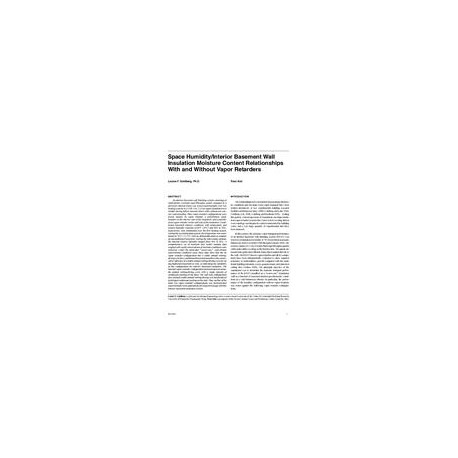No products
 View larger
View larger Space Humidity/Interior Basement Wall Insulation Moisture Content Relationships With and Without Vapor Retarders
M00003230
New product
Space Humidity/Interior Basement Wall Insulation Moisture Content Relationships With and Without Vapor Retarders
Conference Proceeding by ASHRAE, 2001
Louise F. Goldberg, Ph.D., Traci Aloi
In stock
More info
Full Description
An interior basement wall finishing system consisting of mold/mildew resistant rigid fiberglass panels mounted in a polyvinyl chloride frame was tested experimentally over two heating seasons in a 19 ft, 4 in. (5.9 m) square foundation test module having hollow masonry block walls without any exterior waterproofing. Three vapor retarder configurations were tested, namely, no vapor retarder, a polyethylene vapor retarder on the interior side of the insulation, and a polyethylene vapor retarder on the wall side of the insulation. Conditioned basement interior conditions with temperature and relative humidity setpoints of 68 °F (20 °C) and 40% to 50%, respectively, were maintained over the first heating season. During the second heating season, the temperature was maintained at 56 °F (13.3 °C) with no dehumidification to emulate an unconditioned basement. During the intervening summer, the internal relative humidity ranged from 50% to 82%. A comprehensive set of transient and weekly manual data coupled with weekly observations of moisture conditions were collected. Under the particular "worst-case," cold-climate experimental conditions used, these data show that the no vapor retarder configuration has a stable annual wetting/ drying cycle for a conditioned basement and allows the conservative inference of a stable annual wetting/drying cycle for an unconditioned basement as well, so indicating the suitability of this configuration for interior basement insulation. The internal vapor retarder configuration demonstrated an unstable annual wetting/drying cycle with a single episode of condensate pooling on the floor. The wall-side configuration also yielded a stable annual wetting/drying cycle but produced prolonged condensate pooling on the slab. Thus, neither of the latter two vapor retarder configurations was demonstrated experimentally to be appropriate for long-term usage with this interior basement insulation system.
Authors: Louise F. Goldberg, Ph.D., Traci Aloi
Citation: Indoor Air Quality 2001 Moisture, Microbes, and Heath Effects: Indoor Air Quality and Moisture in Buildings Conference Papers
Keywords: November, California, 2001, IAQ
Citation: IAQ Conference: IAQ 2001

